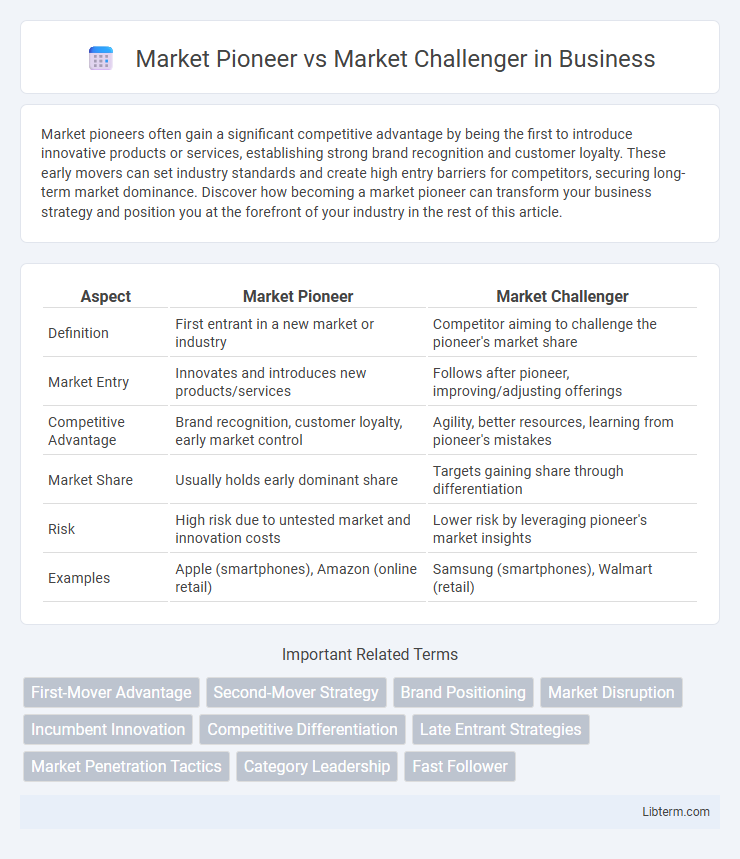Market pioneers often gain a significant competitive advantage by being the first to introduce innovative products or services, establishing strong brand recognition and customer loyalty. These early movers can set industry standards and create high entry barriers for competitors, securing long-term market dominance. Discover how becoming a market pioneer can transform your business strategy and position you at the forefront of your industry in the rest of this article.
Table of Comparison
| Aspect | Market Pioneer | Market Challenger |
|---|---|---|
| Definition | First entrant in a new market or industry | Competitor aiming to challenge the pioneer's market share |
| Market Entry | Innovates and introduces new products/services | Follows after pioneer, improving/adjusting offerings |
| Competitive Advantage | Brand recognition, customer loyalty, early market control | Agility, better resources, learning from pioneer's mistakes |
| Market Share | Usually holds early dominant share | Targets gaining share through differentiation |
| Risk | High risk due to untested market and innovation costs | Lower risk by leveraging pioneer's market insights |
| Examples | Apple (smartphones), Amazon (online retail) | Samsung (smartphones), Walmart (retail) |
Introduction to Market Pioneer and Market Challenger
Market pioneers are companies that introduce new products or services, establishing a strong brand presence and capturing early market share by shaping consumer preferences and setting industry standards. Market challengers enter an established industry, directly competing with market leaders through innovation, aggressive marketing, or improved value propositions to gain market share. The strategic positioning of market pioneers often provides long-term competitive advantages, while challengers focus on leveraging existing market dynamics to disrupt or overtake incumbents.
Defining Market Pioneer: Key Characteristics
A Market Pioneer is characterized by its role as the first mover in introducing innovative products or services, setting industry standards and shaping consumer preferences. This entity invests heavily in research and development to establish brand dominance and create high entry barriers for competitors. Market Pioneers often benefit from significant first-mover advantages, including strong customer loyalty and the ability to influence market trends.
Understanding the Role of Market Challenger
Market challengers play a critical role by directly targeting market leaders through aggressive marketing strategies and innovation to capture market share. They analyze competitors' weaknesses and leverage emerging trends to differentiate their products and services effectively. This proactive approach drives industry evolution and intensifies competition, ultimately benefiting consumers with more choices and improved offerings.
Major Differences: Market Pioneer vs Market Challenger
Market pioneers are first movers who introduce innovative products or services, establishing brand recognition and customer loyalty early, whereas market challengers enter later, aiming to capture market share by improving on or differentiating from the pioneer's offerings. Market pioneers often face higher risks and costs in developing new markets, while challengers benefit from observing market trends and consumer behavior to refine strategies. The competitive focus of pioneers is on market creation and expansion, while challengers prioritize aggressive tactics like pricing, promotion, and product enhancements to dethrone the leader.
Advantages of Being a Market Pioneer
Market pioneers benefit from establishing strong brand recognition and customer loyalty early, which creates significant entry barriers for competitors. They often capitalize on first-mover advantages by setting industry standards and securing prime access to limited resources or distribution channels. This early positioning enables pioneers to shape market expectations and influence consumer preferences, resulting in a sustainable competitive edge.
Strengths and Strategies of Market Challengers
Market challengers leverage aggressive strategies such as targeted marketing campaigns and product innovation to capture market share from market pioneers. Their strengths include agility in responding to consumer needs and the ability to exploit gaps left by pioneers' slower adaptation or higher costs. These challengers utilize tactics like price competition, product differentiation, and market segmentation to effectively challenge established industry leaders.
Case Studies: Successful Pioneers and Challengers
Market pioneers like Apple with the iPhone revolutionized the smartphone industry by introducing innovative features and establishing strong brand loyalty, setting a high entry barrier for followers. Market challengers such as Samsung leveraged aggressive marketing and rapid product innovation to capture significant market share, often adapting and improving upon pioneer innovations. Case studies reveal that successful challengers continually monitor pioneer weaknesses while pioneers sustain their lead through continuous innovation and ecosystem development.
Market Entry Strategies: Pioneer vs Challenger Approaches
Market pioneers establish first-mover advantages by entering new markets with innovative products, creating brand recognition and customer loyalty that can be difficult for challengers to overcome. Market challengers adopt aggressive strategies such as targeted campaigns, improved product features, and competitive pricing to capture market share and disrupt the leader's position. Strategic timing, resource allocation, and understanding consumer preferences significantly influence the success of both pioneer and challenger market entry approaches.
Risks and Challenges Faced by Pioneers and Challengers
Market pioneers face significant risks such as high initial investment costs, market uncertainty, and the challenge of educating consumers about new products or services. Market challengers encounter risks including aggressive competitive retaliation, difficulties in differentiating their offerings, and the need to overcome established brand loyalty held by pioneers. Both must strategically manage innovation and resource allocation to sustain market position amidst constant industry evolution.
Choosing the Right Strategy: Pioneer or Challenger?
Choosing between a market pioneer and a market challenger strategy depends on a company's resources, risk tolerance, and market conditions. Market pioneers capitalize on first-mover advantages, establishing brand recognition and customer loyalty early, while market challengers benefit from market insights to improve products and capture market share with less risk. Analyzing competitive dynamics, innovation capabilities, and timing helps determine the optimal approach for sustainable growth and profitability.
Market Pioneer Infographic

 libterm.com
libterm.com